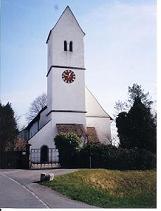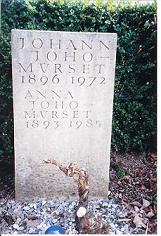| Click To Access |
|
Although Joho's live throughout Switzerland, most live or find their origins in or near the villages of Auenstein and Schinznach. Both are found in the Canton of Aargau (Red X Below) close to the German Border.
The Canton Aargau comprises 1,405 square Km in north central Switzerland with a population of 550,000. It is bordered by Germany in the North and the Cantons Baselland, Solothurn and Bern on the West, Zurich and Zug on the East and Canton of Lucerne in the South. The Canton name Aargau is derived from the locaton of the Aar River.
The Canton is divided into 11 districts (shown in Figure) each with its own capital. Auenstein (A) and Schinznach (S) are communities in the Brugg District.
The rivers Aare, Reuss, and Limmat flow through the Capital city of Brugg forming a tributary in the northeast. The city of Brugg takes its name from a bridge over the Aare river built in Roman times.
The community of Auenstein seen in above views with community flag has approximately 1200 inhabitants today. The area of the community is approximately 1,300 acres. Auenstein is 375 meters (1,231 ft) above sea level on the south side of the Gislifuh chain of mountains and is located in a small valley near the stream of Aare. Auenstein is on the western top of the county Brugg and is a neighbor to the cement industry in Wildegg. The community is located between the towns of Aargau and Brugg.
The early settlers were thought to have settled on a step underneath the mountain. In 1930, prehistorical artifacts were discovered. Although the artifacts did not tell them too much about the early settlers, they did prove that there was a settlement there. The history of the village is very closely connected to castles and churches.
The village was first named after Count von Gowenstein. From 1212 to 1300 the village was named Gowenstein. From 1317 to 1542, it changed from the name Gouwenstein to Gauenstein, and today is called Auenstein.
The first castle was built around the eleventh century by the Habsburger Empire. The first time it was mentioned was when the Count of Gowenstein became the owner in 1212. The castle owned and ruled the community of Auenstein. The count governed the entire community and had his own court system. The ownership of Auenstein changed hands in 1307 from the Count of Gowenstein to Herren von Rynach, through the Duke of Austria. The Herren von Rynach built the first church in Auenstein in 1302. The castle burned in 1389 when it was attacked by the Austrians and Berners. During the attack, approximately 100 Auensteiners were killed.
The castle stayed in ruins until the 1400's. In 1415 the Berners took over the ownership of Auenstein and the villagers now had to work for them. In the fifteenth century the ownership changed frequently. In 1465, it changed from the Herren von Rynach to Schultheissen Heinrich Hasfurter von Luzern. Hasturter's son then turned Auenstein over to Ritter Hansrudolf von Luternau in 1487. In 1491, it changed hands again, to Ritter Heman von Mulinen and his brother, Albrecht. In 1648, General Hans-Ludwig von Erlach resided there. In 1732, his heirs sold it directly to Bern. It was now under the ownership of the land, not under the ownership of a ruling family. In 1777, Bern auctioned off parcels of land to the people. The ruins of the castle were under private ownership. The whole community was part of the newly founded county of Aargau. In 1858, the castle was remodeled to accomodate living quarters and a kitchen. In 1927, Dr. Urech turned the castle over to Frau Hoffman, who, in 1928-29, made some more major renovations. By the end of the remodeling, it looked less like ruins and more like a castle. In 1956, industrialist A. Hug bought the castle and added a park. In 1972, Hermann Reller, a contractor, bought the castle.
 |
 |
In 1952, evidence was discovered that there was a church in Auenstein around the eleventh century. The first written record of the church was taken by the Pope in 1302. The first record of a priest in Auenstein was recorded in 1333. In the fourteenth century, a tower was added and the length of the church was extended. The addition of the choir loft that still remains today was built in the fifteenth century.
In 1572 and 1573 the church was once again renovated. Two bells were added in 1610 and 1611. In 1651, the length of the church was again extended and a new pulpit was added. The outside was renovated in 1843 and again in 1943, and in 1952 the inside was renovated. In 1966, a four bell system was installed. In the following years, the outside was repainted and a new clock was installed.
The first record of a Joho family was found in a baptismal record in 1585.
Art Yoho of Columbus Ohio visited Auenstein in 2003 and provided the photo of the old church described above and a Joho grave from the cemetery located on the church grounds. Art said there were a number of Joho grave sites in the cemetery.
Note: Family trees may be added in future
![]()
Schinznach Dorf is also located in the Brugg District of Canton Aargau. The above picture comes from a web page describing Schinznach (in German) The flag above right is the community flag.
I have not been able to find the history of Schinznach and hope that someone will send me one for others to read.
The earliest known Joho's in Schniznach arrived in 1528. Herman Eiermann who published a history of Conrad Joho (1673-1728) reported that this Unknown Named Joho was the grandson of Gery Joho (ca 1435-?) whose father was Routschmann Joho (ca 1395-?).. Routschmann is the oldest known Joho and lived in Baden. Eiermann also reports that the following six Joho's were known to have lived in Schinznach:
Note: For some browsers move cursor over "Tree" to reveal expand symbol